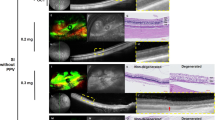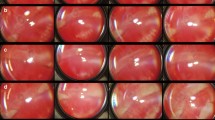Abstract
Full-thickness scleral diathermy using a standard electrode causes significant scleral damage and necrosis. Use of a modified (Jabbour's) diathermy electrode appears to cause minimal scleral damage. We evaluated the scleral changes following transscleral diathermy application using standard and modified diathermy electrodes to the peripheral retina and ciliary body. Twelve Dutch belted pigment rabbits were used in our experiment. Three eyes each were subjected to transscleral diathermy using standard and modified electrodes to produce chorioretinal scars and cyclodestruction. Eyes were examined with the slit lamp and indirect ophthalmoscope at weekly intervals for 4 weeks. Light and transmission electron microscopy was performed 1 hour after diathermy application in 4 animals and in the remaining 8 animals at 4 weeks. Chorioretinal scarring and ciliary body atrophy were successfully induced with both types of electrodes. However, scleral damage was less severe in eyes treated with the modified electrode as compared with the standard electrode.
Similar content being viewed by others
References
Schepens CL. Current management of retinal detachment: progress or chaos? Ann Ophthalmol 1971; 3: 21–41.
Schepens CL. Methods of producing a chorioretinal scar. I. Diathermy. In: Retinal Detachment and Allied Diseases. Saunders, Philadelphia, pp 289–99, 1983.
Albaugh CH, Dunphy EB. Cyclodiathermy: an operation for the treatment of glaucoma. Arch Ophthalmol 1942; 27: 543–57.
de Guillebon HF, Eng D, Ishii U. Scleral changes during diathermy application: influence of electrode type. Arch Ophthalmol 1970; 83: 752–9.
Beckman H, Leff S, Sugar HS. Scleral bursting strength. Results after treatment with ruby laser, cryotherapy, or diathermy. Arch Ophthalmol 1975; 93: 428.
Elzeneiny I, deGuillebon HE Scleral damage in diathermy. Am J Ophthalmol 1970; 69: 754–62.
Jabbour M, McCormick SA, Gong H. Transscleral and transconjunctival diathermy. Retina 1989; 9: 127–30.
Oats MF, Zak RD, Jabbour NM. Cyclodestruction with transconjunctival diathermy in the rabbit model. Invest Ophthalmol Vis Sci 1992; 33 (Suppl): 1269.
Campochiaro PA, Kaden IH, Vidaurri-Leal J, Glaser BM. Cryotherapy enhances intravitreal dispersion of viable retinal pigment epithelial cells. Arch Ophthalmol 1985; 103: 434–6.
Singh AK, Michels RG, Glaser BM: Scleral indentation following cryotherapy and repeat cryotherapy enhance release of viable retinal pigment epithelial cells. Retina 1986; 6: 176–8.
Author information
Authors and Affiliations
Additional information
Supported in part by U.S. Public Health Service grants EY07541 and EY02377 from the National Eye Institute, National Institutes of Health, Bethesda, MD
Rights and permissions
About this article
Cite this article
Bhatt, N., Peyman, G.A. & Karaçorlu, M. Scleral damage: comparison of standard and modified diathermy electrodes. Int Ophthalmol 17, 255–258 (1993). https://doi.org/10.1007/BF01007792
Accepted:
Issue Date:
DOI: https://doi.org/10.1007/BF01007792




